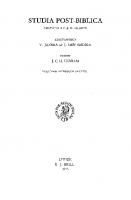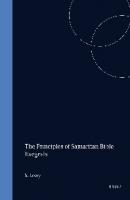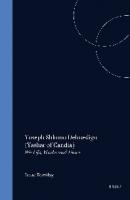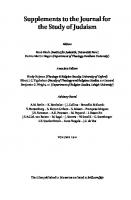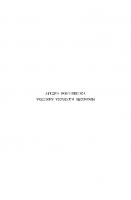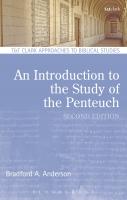The Modern Study of the Mishna (Studia Post Biblica - Supplements to the Journal for the Study of Judaism) 9004036695, 9789004036697
Hardcover, no dust jacket. Ex-library, stained cover.
136 80 27MB
English Pages 283 [312] Year 1973
Title Page
Copyright Page
Dedication
Table of Contents
Preface
Foreword
List of Abbreviations
Transliterations
I. The Traditional Study of the Mishnah
PART I THE ACHIEVEMENT OF JACOB N. EPSTEIN
II. Jacob N. Epstein’s Introduction to the Text of the Mishnah
III. Jacob N. Epstein on the Formation of the Mishnah
PART II THE BEGINNING OF CRITICAL STUDY
IV. The Pioneer: Zecharias Frankel
V. Jacob Brüll: The Mishnah as a Law-Code
VI. Hirsch Mendel Pineles: The First Critical Exegete
PART III THE HISTORIANS AND THE MISHNAH
VII. The Talmudic Historians: N. Krochmal, H. Graetz, I. H. Weiss, and Z. Jawitz
VIII. David Hoffmann’s The First Mishnah
IX. Y. I. Halevy
X. Joachim Oppenheim
PART IV LITERARY CRITICS
XI. J. S. Zuri
XII. David Weiss Halivni on the Mishnah
XIII. Abraham Weiss
PART V RECENT ISRAEL CONTRIBUTIONS
XIV. Ḥanokh Albeck on the Mishnah
XV. Abraham Goldberg
XVI. Benjamin DeVries
Bibliography
Index of Talmudic Passages
General Index
Recommend Papers
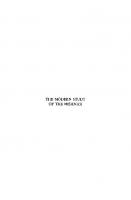
- Author / Uploaded
- Jacob Neusner (editor)
File loading please wait...
Citation preview
THE MODERN STUDY OF THE MISHNAH
STUDIA POST-BIBLICA INSTITUTA A P. A. H. DE BOER
ADIUVANTIBUS
T. JANSMA
ET
J.
SMIT SIBINGA
EDIDIT
J.
C. H. LEBRAM
VOLUMEN VICESIMUM TERTIUM
LEIDEN
E.
J.
BRILL 1973
THE MODERN STUDY OF THE MISHNAH EDITED BY
JACOB NEUSNER Professor of Religious Studies Brown University
LEIDEN
E.
J. BRILL 1973
ISBN
90 04 03669 5
Copyright 1973 by E. J. Brill, Leiden, Netherlands All rights .reserved. No part of this book may be reproduced or translated in any form, by print, photoprint, microfilm, microfiche or any other means without written permission from the publisher PRINTED IN THE NETHERLANDS
For Geza Vermes
TABLE OF CONTENTS Preface . . . . . . . . Foreword
IX
JACOB NEUSNER
XI
List of Abbreviations Transliterations . . . . .
xxv XXVII
I. The Traditional Study of the Mishnah JOEL H. ZAIMAN . . . .
1
PART I
THE ACHIEVEMENT OF JACOB N. EPSTEIN II. Jacob N. Epstein's Introduction to the Text of the
Mishnah
BARUCH MICAH BoKSER
.
.
.
.
.
.
.
.
Ill. Jacob N. Epstein on the Formation of the Mishnah BARUCH M1cAH BoKSER
.
.
.
.
.
.
.
.
.
.
13 37
PART II
THE BEGINNING OF CRITICAL STUDY IV. The Pioneer: Zecharias Frankel JOEL GEREBOFF
.
.
.
.
.
.
.
.
.
.
59
.
76
V. Jacob Brull: The Mishnah as a Law-Code GARY G. PORTON
.
.
.
.
.
.
.
.
VI. Hirsch Mendel Pineles: The First Critical Exegete JOEL GEREBOFF
.
.
.
.
.
.
.
.
.
.
.
.
.
.
90
PART III
THE HISTORIANS AND THE MISHNAH VII. The Talmudic Historians: N. Krochmal, H. Graetz, I. H. Weiss, and Z. Jawitz WILLIAM SCOTT GREEN
.
.
.
.
VIII. David Hoffmann's The First Mishnah CHARLES PRIMUS
107 122 VII
TABLE OF CONTENTS IX. Y. I. Halevy BARUCH MICAH BoKSER . . . . . . . . . . . . X. Joachim Oppenheim JOEL GEREBOFF . . . . . . . . . . . . . . . .
J.
155
PART IV LITERARY CRITICS
S. Zuri WILLIAM Scorr GREEN . . . . XII. David Weiss Halivni on the Mishnah JOEL GEREBOFF . XIII. Abraham Weiss CHARLES PRIMUS XL
135
169 180
197
PART V RECENT ISRAEL CONTRIBUTIONS XIV. I:Ianokh Albeck on the Mishnah GARY G. PORTON . . . XV. Abraham Goldberg WILLIAM Scorr GREEN XVI. Benjamin DeVries CHARLES PRIMUS . . . . . . Bibliography Index of Talmudic Passages General Index . . . . . .
VIII
209 225 242 256 270
273
PREFACE The editor and authors thank Brown University for bearing the costs of preparing the manuscript for press and of the indices. The Department of Religious Studies at Brown University has so devoted its resources to the study of the History of Religions: Judaism that we might do our work together. We know no words fully to convey our gratitude to our University. We appreciate the inclusion of our work in this series and its publication, in the usual handsome form, by E. ). Brill. The director, Mr. F. C. Wieder, Jr., encouraged us to plan and execute this volume as a companion to The Formation of the Babylonian Talmud. Studies in the Achievements of Late Nineteenth and Twentieth Century Historical and Literary-Critical Research (Leiden, 1970: E. ). Brill. Studia Post-biblica, Volumen Septimum Decimum ). Dr. Geza Vermes, Oxford University, Visiting Professor of Religious Studies at Brown University in 1970-1971, provided valuable instruction for most of the students represented here. Like Professors Wendell S. Dietrich and Horst R. Moehring, to whom the earlier studies were dedicated, he made an important contribution to the development of the graduate program in History of Religions: Judaism at Brown University. It was therefore thought appropriate to dedicate this volume to this valued friend and teacher. Providence, Rhode Island July 28, 1972 17 Av 5732
). N.
IX
FOREWORD JACOB NEUSNER The Mishnah of Judah the Patriarch, produced about 200 A.D., not only stood at the end of approximately a hundred and thirty years of rabbinic legal study, but also laid the foundations for the next three hundred in the Palestinian and Babylonian rabbinic circles, and so provided the structure for the Palestinian and Babylonian Talmuds. It is a deceptive document. Because of the simplicity of its construction and the lucid style of its expression, the Mishnah seems more open and easily understood than it really is. The earliest generations of Palestinian and Babylonian Amoraim, moreover, accomplished so much in the analysis and exegesis of the Mishnah that later on attention turned to other documents and problems. Consequently people have assumed more is known about the Mishnah, its meaning and its history, than is actually the case. When, moreover, the evidence of Tosefta, not to mention that in the Tannaitic Midrashim, the Tannaitic sayings in the Palestinian Gemara, and the beraitot in the Babylonian Gemara, was taken into account, it was supposed that one knew about the Mishnah pretty much everything one needed. From the third to the nineteenth century, therefore, the Mishnah was read in the light of the Gemarot, particularly of Babylonia, and rarely formed the focus of attention on its own. Only in the nineteenth century did scholars, with Hirsch M. Pineles at the start, begin to elucidate the Mishnah in its own terms-without first attending to the opinions of the Amoraim and later commentators-and even they had great difficulty first in articulating and then in breaking free of the traditional presuppositions. Traditional study of the Mishnah, as of other ancient holy books of rabbinic Judaism, pays close attention to the exegesis of individual words and sentences, to the interpretation of their meaning, and to the application of that meaning to legal problems. The problems emerge chiefly from the contents of the text; and solutions are weighed by criteria internal to the text. A second form of study of the Mishnah is historical. Historical study stands outside of the Mishnah and asks questions extrinsic to the individual sentences and to their meanings. Historical study begins XI
FOREWORD
with questions about the Mishnah as a whole, its origins, and the development of its law. When, however, the answers to historical and literary questions are arrived at from other criteria in addition to the information supplied by the early students of the Mishnah on the basis of their theological presuppositions, and when that information is critically evaluated in the light of the motives behind it and the external evidence, then we have entered the modern era in the study of the ancient text. What is "modern" about the modern study of the Mishnah is not merely an interest in historical, as opposed to exegetical and legal, problems, but the critical evaluation of the evidence. The first and greatest historian of the Talmud was Sherira Gaon, who lived in the ninth century; one cannot say that with him began the "modern" age in Mishnah-study. But because of his historical interests he stands as the most important precurser to the modern study of the Mishnah. In the nineteenth century Sherira's picture retained influence far out of proportion to its credibility. It was taken for granted, never tested against internal evidence. Sherira so shaped the imagination of the nineteenth century historians that the questions they raised were more or less identical to those thought important-and answerable-by Sherira. The main lines of his "history of the Mishnah" were as follows. Sherira was asked how the Mishnah was written down? Who began to write it? Was it the "Men of the Great Assembly" which began the work, so that each succeeding generation added to it? Sherira thus is asked a fundamentally historical question, and he goes about answering it by composing narrative history: the story of the Mishnah, as revealed in the pertinent, historical-narrative sayings in the Mishnah itself, supplemented by sayings and stories in other Talmudic documents. Sherira answers that Judah the Patriarch was responsible for the Mishnah as we have it. But the later rabbis in the chain ending with Judah accurately preserved what the earlier ones had handed on. The early generations, however, were not named; only the leaders of each generation left their names on the laws. Initially the laws were fully understood and everyone grasped the reasons for them. Therefore no disputes 'marred' the oral Torah. The first difference in law had to do with 'laying on of hands' (M. I:Iag. 2 :2). After the destruction of the Temple, the masters tended to vary their language while teaching the laws. This, together with upheavals of war and poor discipleship, tended to produce disputes the laws and the reasons behind them. Sherira then reviews the several generations after 70, which were XII
FOREWORD
supposed to be responsible for organizing and preserving what they had received from the former generations. In the course of his narrative he alludes to a number of Talmudic stories, all of which he takes at face as accurate accounts of what actually was said and done on the several occasions they allude to. The disciples of 'Aqiba were ultimately responsible for preserving the whole, in particular, Meir. Judah the Patriarch studied with the masters of Meir's generation. The traditions were preserved in the names of individuals or of the majority, but nothing was lost. Nothing was written down until the time of Judah the Patriarch. But the oral traditions were carefully preserved. Each master taught exactly what his master had given him, in the precise words of the master, back to the Great Assembly. Nevertheless, for the reasons given above, differences among traditions developed, and Judah the Patriarch determined to produce a single consistent document. Judah the Patriarch therefore gathered all the traditions, and, in times of peace, was able to produce the Mishnah as the corpus and summary of the antecedent traditions. It was written down lest it be forgotten in times of stress (B. M. Lewin, ed., lggeret Rav Sherira Ga'on [Haifa, 1921], pp. 4-35). Sherira, it is widely supposed, shaped his account of the history of the "Oral Torah" to defend the rabbinic tradition from the attack of Qaraism. Therefore he stressed the perfection of the rabbinic process of formulating and transmitting traditions, claiming that the Oral Torah of rabbinism went back, without interruption, to the Men of the Great Assembly, and thence to Sinai. But the alleged formative, tendentious factors in Sherira's history were not taken into account by later scholars, who in one way or another mostly repeated the details he supplied and replicated his viewpoint. What is of interest is Sherira's formulation of the questions and his method of answering them. His questions take for granted that the Mishnah. is a unitary document, with a one-dimensional history; that it is wholly the work of a single line of masters, who, one after the other, carefully preserved what had gone before; that it has a history recovered in the pertinent stories contained in Talmudic literature. His answers therefore are reached by collecting the Talmudic stories and putting them into a simple chronological order. His presuppositions are that (1) the whole corpus of traditions was memorized; (2) the system of master-disciple relationships was permanent and extended back into remote antiquity; (3) all traditions were everywhere available; (4) Judah the Patriarch was the single authority responsible XIII
FOREWORD
for the final compilation; and (5) Judah produced a single document with no important textual problems. Clearly, an interest in historical questions is not unique to modern scholars. Those who told historical and biographical stories in Talmudic times and those who later on composed histories based on such stories obviously wanted to reconstruct the past. But until the nineteenth century-and, for Talmudic studies, until the last third of the twentieth century-it was routinely taken for granted that any story in a holy book accurately portrays exactly what happened. The story itself has no "history," but it is history. No special interests or viewpoints are to be found in a given historical account. Everything is taken at face value. To pious historians it was unthinkable that anyone would either lie or make up a story for his own partisan purposes. They never asked, Cui bona? To whose interest is it to tell a given story? But in modern times- beginning long before the Enlightenment-people learned to take a skeptical position vis a vis the sacred histories and holy biographies of the earlier generations. They asked about the tendencies of stories and the point the story teller wished to make, and wondered not only about whether the events reported in a story "really" happened, but also about the situation from which a given story had arisen and about which it might supply accurate testimony. They asked how the story teller knew the facts of the case. Who told him? If he was an eye-witness, on whose side did he stand in a situation of conflict? No reporters were present to take down verbatim what was said and done at the various incidents recorded in the rabbinic traditions. Therefore all we have are, at best, traditions about such events, given both form and substance on some other, later occasion than that of which they speak. But often we have not traditions but mere legends, fabrications quite unrelated to the events they purport to relate. Such a skeptical attitude had been well established in New Testament and Tanakh studies by the early nineteenth century. Scholarship in these and related fields showed the necessity of analyzing the components of stories and asking how each element took shape and where and when the several elements were· put together. But with rabbinic materials, aside from some reservations about obvious miracles, one rarely discerns, among nineteenth or even most twentieth century scholars, any desire to go beyond the Talmudic stories in attempting to understand the historical background of texts. And when rabbinic scholars did try to question the presuppositions of XIV
FOREWORD
the texts, they did so unsystematically, chiefly for exegetical, not historical purposes. Only in recent times have various scholars of rabbinic literature in different ways shown that one must recognize the hidden historical motives and the complex literary situation of rabbinic literature. Those motives and that situation make it impossible to read the texts as completely reliable historical witnesses. They require that we ask about the Mishnah a number of new questions. First, is the Mishnah a unitary document, or is it a collection of many documents, not all of them of the same sort, but deriving from different sources? Second, can we rightly speak of a single editor who stands behind the compilation as a whole? Third, do we actually have a single, original Mishnah-text, which we may recover among the various, often conflicting textual testimonies? Or is "The Mishnah" an artificial construct, concealing the many Mishnahs - in part or in the whole-available in antiquity? Fourth, does the Mishnah stand at the end of a single line of development, or is it the confluent of many streams of tradition and growth? Are its contents the work of a single group, or party, in ancient Judaism, or must we make distinctions among various types of law and suggest which types are produced by one sort of political party, social group or historical process, which by another? If the "sages," meaning the Pharisees, did not govern pre-70 Palestine, then how shall we account for those Mishnaic laws which probably come from the period before 70, but deal with areas of public life not then subject to Pharisaic control? Was there a common law in ancient Palestine, to which' all groups subjected themselves, and which in time entered the rabbinic tradition? How were the several types of traditions formulated and transmitted? Can we take for granted the historical accuracy of the rabbinic picture of a master's formulating a sentence and orally teaching it to his disciple, who then memorized the sentence and in time passed it on the same way to his disciple? Or were there a number of different means by which materials were formulated in their final stage and handed on to the next generation? In asking these questions, we have moved a very long way from the historical agenda laid down by Sherira. These too are historical questions, but they are not questions of narrative and cannot be answered by a retelling the thrice-told stories and sayings in rabbinic literature that would seem to provide pertinent information. For the critical scholar such stories and sayings reveal primarily the situations
xv
FOREWORD
of the people who made them up, and normally we know who those people were. They do not stand as unimpeachable evidence about the Mishnah's own history. They tell us only what later generations thought to claim about that history. One need not, therefore, refute in detail histories made up on the basis of Talmudic tales. One need only point out that such histories are wholly uncritical, omit all reference to the internal evidence revealed by Mishnah itself, and generally exclude from discussion the literary evidences available in cognate literature, particularly Tosefta. Nor need one refute the nineteenth and twentieth century histories of the Mishnah which, using the Talmudic materials, go on to reinterpret them, to invent new "postulates" about their meaning, to reject one detail of a story in favor of another-in all, to lay claim to a "critical" position towards a literature whose historical usefulness is never in the end called into question or criticized. In such histories we have the pretense of critical scholarship but not its substance. The bulk of the work of nineteenth and twentieth century historians of the Mishnah must be regarded as pseudo-critical, critical in rhetoric but wholly traditional in all its presuppositions and, in the main, primitive and puerile. Like the "critical'' fundamentalists, who postulate that the whale did not really swallow Jonah, but only kept him in his cheek, and like the pseudorthodox who say it was for three hours, not for three days-the "critical" scholars of the modern period have scarcely improved upon the traditional picture. They have merely rearranged some of its elements. Nothing has changed, but much is made of the changes. Sherira's questions and presuppositions predominate throughout the modern study of the Mishnah, with only two exceptions. The first, and greatest, is not treated here at all. Saul Lieberman's Tosefta Kifshufah and Tosefet Rishonim constitute the greatest commentaries to Mishnaic literature ever written. Since Lieberman concentrates on Tosefta, however, the Mishnah is elucidated only as part of a larger framework. This is as it should be, for the Mishnah and Tosefta constitute a single literature-Lieberman demonstrates this on virtually every page of his work- and cannot be studied except in relationship to one another. Lieberman further demonstrates that Tosefta represents the hinge on which all Talmudic 'doors' must turn, so he includes all pertinent materials from the Palestinian Talmud and the Babylonian Talmud's beraitot. What is of interest here is that Lieberman as yet has produced no "introduction" to Mishnah-Tosefta. One reviewer criticized his failure to write an "introduction to XVI
FOREWORD
Tosefta," explaining when the document was written, by whom, for what purpose, and the like. But Lieberman wisely prefers to await the conclusion of his detailed and thorough researches into Mishnah-Tosefta. Only at the end will the accumulated, internal evidence permit him to speculate about the literary and historical traits of the whole compilation. This sage reserve and close attention to internal evidence, not to mention the extraordinary thoroughness, exegetical lucidity, stylistic taste, and prudent judgment, set Lieberman's work apart from anything ever done or ever likely to be done. He has raised scholarship on Mishnah-Tosefta to an entirely new level of achievement. Many generations will profit from his work. But since we have chosen to concentrate on works devoted primarily to the Mishnah, and since Lieberman's work is not yet complete for the whole Tosefta and still lacks the required general introduction, we choose to postpone our account of it. The second exception to the pseudo-critical rule is J. N. Epstein. Epstein asks a deceptively simple question: What is the requirement for a "critical text" of the Mishnah? He shows that such a critical text is hardly possible. Indeed, the textual situation was so fluid, right from the outset, that one may probably have to abandon the concept of the Mishnah as a single corpus of readings and traditions. Rather, he shows, from the beginning the Mishnah was constituted by a not-precisely-limited collection of formulations. The earliest Amoraim did not hesitate to revise what they had received, to produce "the Mishnah" in accordance with their own conceptions of what Rabbi ought to have produced. They did not merely study a received, fixed text; they worked, so to speak, in creative partnership with the founder(s) of the Mishnah(s) in establishing the text(s) they thought viable. Epstein not only showed the fluidity of the Mishnah's text from Rabbi's time onward, but also demonstrated the complexity of the materials received by Rabbi and shaped into the Mishnah. Rabbi drew upon many different sources, and these several sources were themselves characterized by considerable variation in both style and substance. The exact words attributed to earlier authorities might change from one source to the next. Conflicts already existed in the various sources used and preserved by Rabbi. And there were other collections of ancient legal traditions, produced both at the same time and afterward. Internal inconsistencies, successive recensions, distinct collections produced a mass of varying interpretations and alternative readings, and on this basis later masters doctored the Mishnah they XVII
FOREWORD
had received. So the Mishnah as we now have it cannot be said accurately to preserve the Mishnah-text of the Talmudic period. One must then wonder whether we may accurately speak of a single Mishnah-text of any period, even of the period in which "the Mishnah" was actually taking shape. Here, obviously, we are far indeed from the presuppositions and consequent questions of Sherira Gaon. Epstein's monumental conception and the execution of his work may be contrasted with the questions framed by Sherira. Sherira asked, How was the Mishnah written down? What is its history? Epstein begins with the question, What are the evidences for a single, essentially static Mishnah-text? Can we speak of "The Mishnah" at all? He further raises the question of the variety and multiplicity of sources behind the Mishnah. He brings us a long way indeed from the simple account of Sherira. In the light of Epstein's achievements, one may no longer take seriously the questions posed by Sherira, for those questions no longer relate to the document as we now know it. Zecharias Frankel, the founder of the modern study of the Mishnah, appears in comparison to Epstein to belong to the distant past. It would, indeed, be unnecessary to criticize his ideas at all, were they not still taken seriously, as shown by the reprinting of his books and their use in contemporary Israeli scholarship to this day. Frankel operates in a world of private definitions, circular reasoning, and capricious postulates. For him it is unnecessary to prove much, for one may, through defining things properly, obviate the need for proof. He thinks medieval commentaries constitute primary sources for the study of the Mishnah. He furthermore claims that Seder '[oharot is old because it is the largest order (!), that the ancient Jews were all students of the rabbinic Torah, that the structure of the Mishnah was revealed by divine inspiration; and he reveals numerous other marvels. In what way then is he to be regarded as "modern"? The reception of his book supplies the answer. His enemies accused him of treating the Mishnah in a secular spirit and not as a divinely revealed document, the Oral Torah. They said he regarded the Mishnah as the work of men and as a time-bound document. He even explained Mishnaic laws in other ways than by reference to the Babylonian Talmud. For this Frankel was condemned, and correctly so, by the traditionalists of his day, who quite rightly saw in his work a threat to their presuppositions. That his work today is taken seriously among traditionalists tells us that what is said in the name of tradition changes from one century to the next. But scarcely a line of his XVIII
FOREWORD
Darkhe HaMishnah can be taken seriously. The same may be said of Brull, who follows closely on Frankel's path. l:J. Albeck looks upon the Mishnah as the culmination of the process of "oral tradition" beginning in ancient times. He takes for granted that anything not reflective of Scriptural tradition, whether in biblical or apocryphal, pseudepigraphical, or Septuagintal literature, is a reflection of The Oral Tradition of Pharisaic-Rabbinic Judaism. That it might have been invented never enters his head-and he supposes any "oral tradition" must be "the" oral tradition of Pharisaic and rabbinic Judaism. While Albeck is critical of earlier students of the history of the oral Torah, he does not depart from their frame of reference. Indeed, he takes pretty much the position of Sherira, altering details but not the main points. The scholarly agenda formulated by Sherira remain uncriticized and unchanged: "When was the Mishnah written?" He extensively reviews and criticizes the ideas of earlier scholars, as if they had supplied him with viable agenda. So we find ourselves once again in the midst of debates on the work of the Men of the Great Assembly, as if we had the slightest shred of evidence about what they had actually done, let alone a document produced by them or in their days. While Epstein demonstrated, for example, that the tractate
